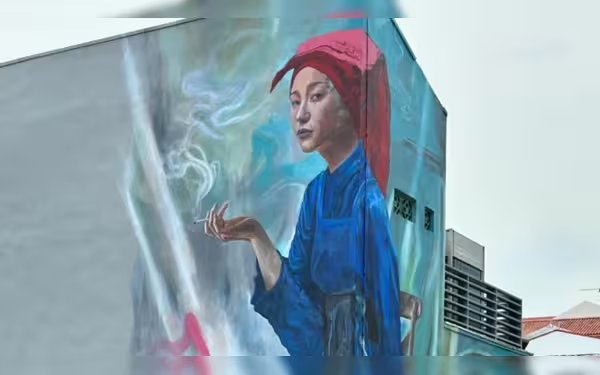Thursday, July 4, 2024 07:03 PM
URA Reassessing Stance on Controversial Chinatown Mural
- URA reevaluating stance on unauthorized mural featuring smoking samsui woman
- Public feedback prompts URA to reconsider support for controversial Chinatown mural
- Artist Sean Dunston hopeful as URA reviews decision on contentious mural
 Image Credits: channelnewsasia
Image Credits: channelnewsasiaThe Urban Redevelopment Authority in Singapore is reevaluating its stance on a controversial mural in Chinatown featuring a smoking samsui woman, highlighting the importance of following proper procedures for creating artworks on conserved buildings.
The Urban Redevelopment Authority (URA) in Singapore is currently reassessing its stance on a mural painted on a Chinatown shophouse that features a young samsui woman smoking. This re-evaluation comes in response to recent public feedback regarding the artwork. Initially, URA had instructed the landlord to remove the cigarette from the mural, as it was completed without prior approval.
According to URA, all proposals for murals on conserved buildings must be submitted for approval by both the building owner and URA before any work can commence. The mural at 297 South Bridge Road was done without proper authorization, leading URA to request the building owner to submit the proposal for assessment.
After consulting with local stakeholders and relevant agencies, URA decided not to support the mural due to its depiction of smoking, which goes against Singapore's anti-smoking policy. However, in light of recent public feedback, URA is now reconsidering its position on the mural.
The artist behind the mural, Sean Dunston, expressed gratitude for URA's decision to review the situation and hopes that the mural will be allowed to remain unchanged. He mentioned an email from URA advising the landlord to hold off on any alterations to the mural until the review is completed.
Singapore is home to over 6,500 conserved shophouses, with guidelines set by URA to ensure that any works done on these buildings do not alter their architectural integrity. Murals are permitted on certain walls of shophouses but must align with the area's character and not contain offensive content.
URA categorizes works on conserved buildings into three categories, with Category 3 being the least impactful. Applicants need to seek permission before carrying out any work, with a response expected within 10 working days. Category 1 and 2 works, which have more significant impacts, require applications by registered professionals.
The controversy surrounding the Chinatown mural arose after URA instructed the removal of the cigarette, following feedback from a member of the public who found the depiction offensive. The incident sparked online debate and garnered significant attention on social media.
The reassessment of the Chinatown mural by URA highlights the importance of following proper procedures when creating artworks on conserved buildings. Public feedback plays a crucial role in shaping decisions, and artists must be mindful of local regulations and sensitivities. As the review continues, the outcome will not only impact this specific mural but also set a precedent for future artistic endeavors in Singapore's heritage-rich areas.













